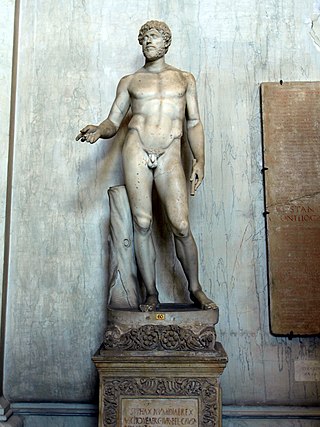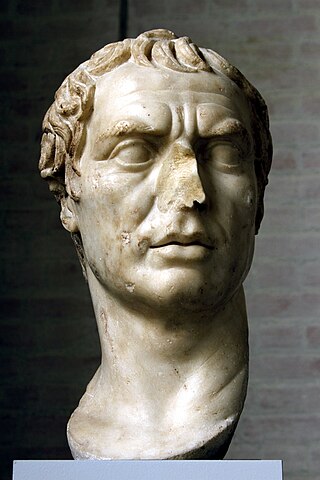Related Research Articles

The Second Punic War was the second of three wars fought between Carthage and Rome, the two main powers of the western Mediterranean in the 3rd century BC. For 17 years the two states struggled for supremacy, primarily in Italy and Iberia, but also on the islands of Sicily and Sardinia and, towards the end of the war, in North Africa. After immense materiel and human losses on both sides, the Carthaginians were defeated. Macedonia, Syracuse and several Numidian kingdoms were drawn into the fighting, and Iberian and Gallic forces fought on both sides. There were three main military theatres during the war: Italy, where Hannibal defeated the Roman legions repeatedly, with occasional subsidiary campaigns in Sicily, Sardinia and Greece; Iberia, where Hasdrubal, a younger brother of Hannibal, defended the Carthaginian colonial cities with mixed success before moving into Italy; and Africa, where Rome finally won the war.
Year 202 BC was a year of the pre-Julian Roman calendar. At the time it was known as the Year of the Consulship of Geminus and Nero. The denomination 202 BC for this year has been used since the early medieval period, when the Anno Domini calendar era became the prevalent method in Europe for naming years.

This article concerns the 200 BC decade, that lasted from 209 BC to 200 BC.
Year 204 BC was a year of the pre-Julian Roman calendar. At the time it was known as the Year of the Consulship of Cethegus and Tuditanus. The denomination 204 BC for this year has been used since the early medieval period, when the Anno Domini calendar era became the prevalent method in Europe for naming years.
Year 206 BC was a year of the pre-Julian Roman calendar. At the time it was known as the Year of the Consulship of Philo and Metellus. The denomination 206 BC for this year has been used since the early medieval period, when the Anno Domini calendar era became the prevalent method in Europe for naming years.
The Battle of Zama was fought in 202 BC in what is now Tunisia between a Roman army commanded by Scipio Africanus and a Carthaginian army commanded by Hannibal. The battle was part of the Second Punic War and resulted in such a severe defeat for the Carthaginians that they capitulated. The Roman army of approximately 30,000 men was outnumbered by the Carthaginians who fielded either 40,000 or 50,000; the Romans were stronger in cavalry, but the Carthaginians had 80 war elephants.
Gnaeus Cornelius Scipio Calvus was a Roman general and statesman during the third century BC. He played a major part in the Second Punic War establishing Roman Rule in the east of the Iberian Peninsula and tying up several Carthaginian armies keeping them from reinforcing Hannibal.

Mago Barca was a Barcid Carthaginian who played an important role in the Second Punic War, leading forces of Carthage against the Roman Republic in Iberia and northern and central Italy. Mago was the third son of Hamilcar Barca, was the brother of Hannibal and Hasdrubal, and was the brother-in-law of Hasdrubal the Fair.

Syphax was a king of the Masaesyli tribe of western Numidia during the last quarter of the 3rd century BC. His story is told in Livy's Ab Urbe Condita. He ruled over a territory extending from present day Constantine to Fez.

Hasdrubal Barca, a latinization of ʿAzrubaʿal son of Hamilcar Barca, was a Carthaginian general in the Second Punic War. He was the brother of Hannibal and Mago Barca.

The Numidians were the Berber population of Numidia .The Numidians were originally a semi-nomadic people, they migrated frequently as nomads usually do but during certain seasons of the year, they would return to the same camp.The Numidians soon became more than pastoralists and started to engage in more urban professions. The Numidians were one of the earliest Berber tribes to trade with Carthaginian settlers. As Carthage grew, the relationship with the Numidians blossomed. Carthage's military used the Numidian cavalry as mercenaries. Numidia provided some of the highest quality cavalry of the Second Punic War, and the Numidian cavalry played a key role in several battles, both early on in support of Hannibal and later in the war after switching allegiance to the Roman Republic. Numidian culture flourished between the end of the Second Punic War and around the Roman conquest, with Massinissa as the first king of a unified Numidia.

The Battle of Ilipa was an engagement considered by many as Scipio Africanus’s most brilliant victory in his military career during the Second Punic War in 206 BC.
The Battle of the Upper Baetis was a double battle, comprising the battles of Castulo and Ilorca, fought in 211 BC during the Second Punic War between a Carthaginian force led by Hasdrubal Barca and a Roman force led by Publius Cornelius Scipio and his brother Gnaeus. The immediate result was a Carthaginian victory in which both Roman brothers were killed. Before this defeat, the brothers had spent seven years campaigning against the Carthaginians in Hispania, thus limiting the resources available to Hannibal, who was simultaneously fighting the Romans in Italy.
Hasdrubal Gisco, a latinization of the name ʿAzrubaʿal son of Gersakkun, was a Carthaginian general who fought against Rome in Iberia (Hispania) and North Africa during the Second Punic War.

The battle of the Great Plains was fought in 203 BC in modern Tunisia between a Roman army commanded by Publius Cornelius Scipio, and allied Carthaginian and Numidian armies commanded by Hasdrubal Gisco and Syphax respectively. The battle was part of the Second Punic War and resulted in a heavy defeat for Carthage.
The Battle of Cirta was fought in 203 BC between an army of largely Masaesyli Numidians commanded by their king Syphax and a force of mainly Massylii Numidians led by Masinissa, who was supported by an unknown number of Romans under the legate Gaius Laelius. It took place somewhere to the east of the city of Cirta and was part of the Second Punic War. The numbers engaged on each side and the casualties suffered are not known.

The battle of Utica was fought in 203 BC between a Roman army commanded by Publius Cornelius Scipio and the allied armies of Carthage and Numidia, commanded by Hasdrubal Gisgo and Syphax respectively. The battle was part of the Second Punic War and resulted in a heavy defeat for Carthage.

Masinissa, also spelled Massinissa, Massena and Massan, was an ancient Numidian king best known for leading a federation of Massylii Berber tribes during the Second Punic War, ultimately uniting them into a kingdom that became a major regional power in North Africa. He is considered the founder of the first Algerian state.
The Battle of Oroscopa was fought between a Carthaginian army of more than 30,000 men commanded by the general Hasdrubal and a Numidian force of unknown size under its king, Masinissa. It took place in late 151 BC near the ancient town of Oroscopa in what is now north western Tunisia. The battle resulted in a heavy Carthaginian defeat.
References
- ↑ Hung, Hing Ming (2011). The Road to the Throne: How Liu Bang Founded China's Han Dynasty. pp. 148–163. ISBN 978-0875868387.
| | This section is empty. You can help by adding to it. (November 2021) |